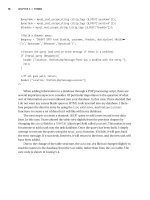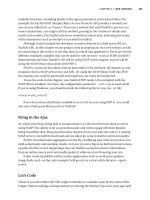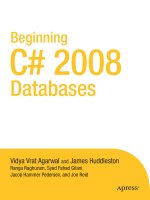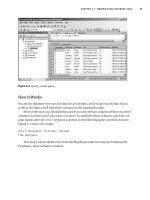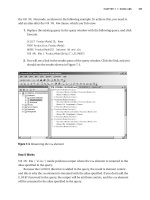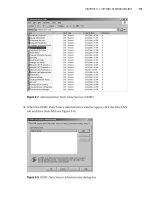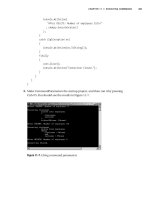Beginning C# 2005 Databases From Novice to Professional phần 8 doc
Bạn đang xem bản rút gọn của tài liệu. Xem và tải ngay bản đầy đủ của tài liệu tại đây (649.24 KB, 52 trang )
10. Run the program with Ctrl+F5. Click the ADO.NET Exception-1 button, and you’ll
see the message box shown in Figure 13-3. Click OK.
11. When the message box in Figure 13-4 appears, click OK, then close the window.
How It Works
It would be highly unusual to miss setting the CommandText property. However, this is an
expedient way to cause an ADO.NET exception. You specify the command for a stored
procedure call, but you don’t specify the stored procedure to call
// Specify that a stored procedure is to be executed
cmd.CommandType = CommandType.StoredProcedure;
// Deliberately fail to specify the procedure
// cmd.CommandText = "sp_Select_AllEmployees";
so when you call the ExecuteReader method, you get an exception, as shown in
F
igure 13-2. Though it’s an unhandled exception, it still gives you an accurate diagnostic
ExecuteReader: CommandText property has not been intiailized.
and it even gives you the option to continue or quit. However, leaving this decision to
users isn’t a very good idea.
After seeing what happens without handling the exception, you place the call in
a
try block:
CHAPTER 13 ■ HANDLING EXCEPTIONS 339
Figure 13-3. Handled exception message
Figure 13-4. Message from finally block
777Xch13final.qxd 11/18/06 2:36 PM Page 339
try
{
// Open connection
conn.Open();
// Create data reader
SqlDataReader dr = cmd.ExecuteReader();
// Close reader
dr.Close();
}
To handle the exception yourself, you code two catch clauses:
catch (System.Data.SqlClient.SqlException ex)
{
string str;
str = "Source:" + ex.Source;
str += "\n" + "Exception Message:" + ex.Message;
MessageBox.Show (str, "Database Exception");
}
catch (System.Exception ex)
{
string str;
str = "Source:" + ex.Source;
str += "\n" + "Exception Message:" + ex.Message;
MessageBox.Show (str, "Non-Database Exception");
}
In the first catch clause, you specify a database exception type. The second catch
clause, which produces the message box in Figure 13-3, is a generic block that catches
all types of exceptions. Note the caption of the message box in this
catch block. It says
Non-Database Exception. Although you may think that a failure to specify a command
string is a database exception, it’s actually an ADO.NET exception; in other words, this
error is trapped before it gets to the database server.
When the button is clicked, since the
CommandText property isn’t specified, an excep-
tion is thrown and caught by the second
catch clause. Even though a catch clause for
SqlException is provided, the exception is a System.InvalidOperationException—a com-
mon exception thrown by the CLR, not a database exception.
The exception message indicates where the problem occurred: in the
ExecuteReader
method. The finally block checks if the connection is open and, if it is, closes it and gives
a message to that effect. Note that in handling the exception, you don’t terminate the
application:
CHAPTER 13 ■ HANDLING EXCEPTIONS340
777Xch13final.qxd 11/18/06 2:36 PM Page 340
finally
{
if (conn.State == ConnectionState.Open)
{
MessageBox.Show ("Finally block closing the connection", "Finally");
conn.Close();
}
}
Try It Out: Handling an ADO.NET Exception (Part 2)
Let’s try another example of an ADO.NET exception. You’ll execute a stored procedure
and then reference a nonexistent column in the returned dataset. This will throw an
ADO.NET exception. This time, you’ll code a specific
catch clause to handle the
exception:
1. Use the sp_Select_All_Employees stored procedure you created in Chapter 12.
If you haven’t created it already, please go to Chapter 12 and follow the steps in
“Try It Out: Creating and Executing a Trivial Stored Procedure.”
2. Insert the code in Listing 13-3 into the body of the button2_Click method.
Listing 13-3. button2_Click()
// Create connection
SqlConnection conn = new SqlConnection(@"
data source = .\sqlexpress;
integrated security = true;
database = northwind
");
// Create command
SqlCommand cmd = conn.CreateCommand();
// Specify that a stored procedure is to be executed
cmd.CommandType = CommandType.StoredProcedure;
cmd.CommandText = "sp_Select_All_Employees";
CHAPTER 13 ■ HANDLING EXCEPTIONS 341
777Xch13final.qxd 11/18/06 2:36 PM Page 341
try
{
// Open connection
conn.Open();
// Create data reader
SqlDataReader dr = cmd.ExecuteReader();
// Access nonexistent column
string str = dr.GetValue(20).ToString();
// Close reader
dr.Close();
}
catch (System.InvalidOperationException ex)
{
string str;
str = "Source: " + ex.Source;
str += "\n" + "Message: "+ ex.Message;
str += "\n" + "\n";
str += "\n" + "Stack Trace: " + ex.StackTrace;
MessageBox.Show (str, "Specific Exception");
}
catch (System.Data.SqlClient.SqlException ex)
{
string str;
str = "Source: " + ex.Source;
str += "\n" + "Exception Message: " + ex.Message;
MessageBox.Show (str, "Database Exception");
}
catch (System.Exception ex)
{
string str;
str = "Source: " + ex.Source;
str += "\n" + "Exception Message: " + ex.Message;
MessageBox.Show (str, "Non-Database Exception");
}
CHAPTER 13 ■ HANDLING EXCEPTIONS342
777Xch13final.qxd 11/18/06 2:36 PM Page 342
finally
{
if (conn.State == ConnectionState.Open)
{
MessageBox.Show ("Finally block closing the connection", "Finally");
conn.Close();
}
}
■Tip Testing whether a connection is open before attempting to close it isn’t actually necessary. The
Close method doesn’t throw any exceptions, and calling it multiple times on the same connection, even
if it’s already closed, causes no errors.
3. Run the program with Ctrl+F5. Click the ADO.NET Exception-2 button, and you’ll
see the message box shown in Figure 13-5. Click OK. When the
finally block mes-
sage appears, click OK, then close the window.
4. F
or a quick comparison, now generate a SQL Server exception, an error that
occurs within the database. Alter the name of the stored procedure in the code
to a name that doesn’t exist within the Northwind database. For example:
cmd.CommandText = "sp_Select_No_Employees";
CHAPTER 13 ■ HANDLING EXCEPTIONS 343
Figure 13-5. Handling a specific ADO.NET exception
777Xch13final.qxd 11/18/06 2:36 PM Page 343
5. Run the program with Ctrl+F5. Click the ADO.NET Exception-2 button, and you’ll
see the message box shown in Figure 13-6. Click OK. When the
finally block mes-
sage appears, click OK, then close the window.
How It Works
First you create the data reader and try to access an invalid column:
// Create data reader
SqlDataReader dr = cmd.ExecuteReader();
// Access nonexistent column
string str = dr.GetValue(20).ToString();
An exception is thrown, because you tried to get the value of column 20, which
doesn’t exist. You add a new
catch clause to handle this kind of ADO.NET error:
catch (System.InvalidOperationException ex)
{
string str;
str = "Source: " + ex.Source;
str += "\n" + "Message: "+ ex.Message;
str += "\n" + "\n";
str += "\n" + "Stack Trace: " + ex.StackTrace;
MessageBox.Show (str, "Specific Exception");
}
When an exception of type System.InvalidOperationException is thrown, this catch
clause executes, displaying the source, message, and stack trace for the exception.
Without this specific
catch clause, the generic catch clause would have handled the
exception. (Try commenting out this
catch clause and reexecuting the code to see
which
catch clause handles the exception.)
CHAPTER 13 ■ HANDLING EXCEPTIONS344
Figure 13-6. Handling a SQL Server exception
777Xch13final.qxd 11/18/06 2:36 PM Page 344
Next, you run the program for a nonexistent stored procedure:
// Specify that a stored procedure is to be executed
cmd.CommandType = CommandType.StoredProcedure;
cmd.CommandText = "sp_Select_No_Employees";
You catch your (first) database exception with
catch (System.Data.SqlClient.SqlException ex)
which leads into the next topic: handling exceptions thrown by the database manager.
Handling Database Exceptions
An exception of type System.Data.SqlClient.SqlException is thrown when SQL Server
returns a warning or error. This class is derived from
System.SystemException and is sealed
so it can’t be inherited, but it has several useful members that you can interrogate to
obtain valuable information about the exception.
An instance of
SqlException is thrown whenever the .NET data provider for SQL
Server encounters an error or warning from the database. Table 13-1 describes the prop-
erties of this class that provide information about the exception.
Table 13-1. SqlException Properties
Property Name Description
Class Gets the severity level of the error returned from the SqlClient data provider.
The severity level is a numeric code that’s used to indicate the nature of the
error. Levels 1 to 10 ar
e informational errors; 11 to 16 are user-level errors; and
17 to 25 are software or har
dware errors. At level 20 or greater, the connection
is usually closed.
Data Gets a collection of key-value pairs that contain user-defined information.
ErrorCode The HRESUL
T of the err
or
.
Errors Contains one or more SqlError objects that have detailed information about
the exception. This is a collection that can be iterated through.
HelpLink The help file associated with this ex
ception.
InnerException Gets the exception instance that caused the current exception.
LineNumber Gets the line number within the Transact-SQL command batch or stored
procedure that generated the exception.
Message The text describing the exception.
Number The number that identifies the type of ex
ception.
Continued
CHAPTER 13 ■ HANDLING EXCEPTIONS 345
777Xch13final.qxd 11/18/06 2:36 PM Page 345
Table 13-1. Continued
Property Name Description
Procedure The name of the stored procedure that generated the exception.
S
erver
T
he name of the computer running the instance of SQL Server that generated
t
he exception.
Source The name of the provider that generated the exception.
StackTrace A string representation of the call stack when the exception was thrown.
State Numeric error code from SQL Server that represents an exception, warning, or
“no data found” message. For more information, see SQL Server Books Online.
TargetSite The method that throws the current exception.
When an error occurs within SQL Server, it uses a T-SQL RAISERROR statement to raise
an error and send it back to the calling program. A typical error message looks like the
following:
Server: Msg 2812, Level 16, State 62, Line 1
Could not find stored procedure 'sp_DoesNotExist'
In this message, 2812 represents the error number, 16 represents the severity level,
and
62 represents the state of the error.
You can also use the
RAISERROR statement to display specific messages within a stored
procedure. The
RAISERROR statement in its simplest form takes three parameters. The first
parameter is the message itself that needs to be shown. The second parameter is the
severity level of the error. Any users can use severity levels 11 through 16. They represent
messages that can be categorized as information, software, or hardware problems. The
third parameter is an arbitrary integer from 1 through 127 that represents information
about the state or source of the error.
Let’s see how a SQL error, raised by a stored procedure, is handled in C#. You’ll cre-
ate a stored procedure and use the following T-SQL to raise an error when the number
of orders in the
Orders table exceeds ten:
if @orderscount > 10
raiserror (
'Orders Count is greater than 10 - Notify the Business Manager',
16,
1
)
Note that in this RAISERROR statement, you specify a message string, a severity level
of
16, and an arbitrary state number of 1. When a RAISERROR statement that you write
contains a message string, the error number is given automatically as
50000. When
CHAPTER 13 ■ HANDLING EXCEPTIONS346
777Xch13final.qxd 11/18/06 2:36 PM Page 346
SQL Server raises errors using RAISERROR, it uses a predefined dictionary of messages to
give out the corresponding error numbers. (See SQL Server Books Online to learn how
to add your own messages to SQL Server’s predefined messages.)
Try It Out: Handling a Database Exception (Part 1): RAISERROR
Let’s raise a database error and handle the exception:
1. Add a button to the Database tab page and change its Text property to Database
Exception-1
. Add a label to the right of this button, and change its Text property
to
Calls a stored procedure that uses RAISERROR.
2. Add a second button to the tab page, and change its Text property to Database
Exception-2. Add a label to the right of this button, and change its Text property
to
Calls a stored procedure that encounters an error.
3. Add a third button to the tab page, and change its Text property to Database
Exception-3. Add a label to the right of this button, and change its Text property
to
Creates multiple SqlError objects. The layout should look like Figure 13-7.
4. U
sing SSMSE, create a stored procedure in Northwind named
sp_DbException_1, as
follo
ws:
create procedure sp_DbException_1
as
set nocount on
declare @ordercount int
CHAPTER 13 ■ HANDLING EXCEPTIONS 347
Figure 13-7. Database tab page
777Xch13final.qxd 11/18/06 2:36 PM Page 347
select
@ordercount = count(*)
from
orders
if @ordercount > 10
raiserror (
'Orders Count is greater than 10 - Notify the Business Manager',
16,
1
)
5. Add the code in Listing 13-4 to the button3_Click method.
Listing 13-4. button3_Click()
// Create connection
SqlConnection conn = new SqlConnection(@"
data source = .\sqlexpress;
integrated security = true;
database = northwind
");
// Create command
SqlCommand cmd = conn.CreateCommand();
// Specify that a stored procedure to be executed
cmd.CommandType = CommandType.StoredProcedure;
cmd.CommandText = "sp_DbException_1";
try
{
// Open connection
conn.Open();
// Execute stored procedure
cmd.ExecuteNonQuery();
}
catch (System.Data.SqlClient.SqlException ex)
{
string str;
str = "Source: " + ex.Source;
CHAPTER 13 ■ HANDLING EXCEPTIONS348
777Xch13final.qxd 11/18/06 2:36 PM Page 348
str += "\n"+ "Number: "+ ex.Number.ToString();
str += "\n"+ "Message: "+ ex.Message;
str += "\n"+ "Class: "+ ex.Class.ToString ();
str += "\n"+ "Procedure: "+ ex.Procedure.ToString();
str += "\n"+ "Line Number: "+ex.LineNumber.ToString();
str += "\n"+ "Server: "+ ex.Server.ToString();
MessageBox.Show (str, "Database Exception");
}
catch (System.Exception ex)
{
string str;
str = "Source: " + ex.Source;
str += "\n" + "Exception Message: " + ex.Message;
MessageBox.Show (str, "General Exception");
}
finally
{
if (conn.State == ConnectionState.Open)
{
MessageBox.Show(
"Finally block closing the connection",
"Finally"
);
conn.Close();
}
}
6. Run the program with Ctrl+F5, then click the Database Exception-1 button. You’ll
see the message bo
x sho
wn in F
igur
e 13-8. Click OK to close the message bo
x,
then OK to close the next one
, then close the windo
w
.
CHAPTER 13 ■ HANDLING EXCEPTIONS 349
Figure 13-8. RAISERROR Database Exception message
777Xch13final.qxd 11/18/06 2:36 PM Page 349
Observe the caption and contents of the message box. The source, message, name
of the stored procedure, exact line number where the error was found, and name of the
server are all displayed. You obtain this detailed information about the exception from
the
SqlException object.
How It Works
In the sp_DBException_1 stored procedure, you first find the number of orders in the
Orders table and store the number in a variable called @ordercount:
select
@ordercount = count(*)
from
orders
Then, if @ordercount is greater than ten, you raise an error using the RAISERROR
statement:
if @ordercount > 10
raiserror (
'Orders Count is greater than 10 - Notify the Business Manager',
16,
1
)
Then, in the button3_Click method, you execute the stored procedure using the
ExecuteNonQuery method within a try block:
try
{
// Open connection
conn.Open();
// Create data reader
cmd.ExecuteNonQuery();
}
When the stor
ed procedure executes, the
RAISERROR statement
raises an error, which
is conv
er
ted to an exception by ADO.NET. The following code handles the exception:
CHAPTER 13 ■ HANDLING EXCEPTIONS350
777Xch13final.qxd 11/18/06 2:36 PM Page 350
catch (System.Data.SqlClient.SqlException ex)
{
string str;
str = "Source: " + ex.Source;
str += "\n"+ "Number: "+ ex.Number.ToString();
str += "\n"+ "Message: "+ ex.Message;
str += "\n"+ "Class: "+ ex.Class.ToString ();
str += "\n"+ "Procedure: "+ ex.Procedure.ToString();
str += "\n"+ "Line Number: "+ex.LineNumber.ToString();
str += "\n"+ "Server: "+ ex.Server.ToString();
MessageBox.Show (str, "Database Exception");
}
Try It Out: Handling a Database Exception (Part 2):
Stored Procedure Error
Now let’s see what happens when a statement in a stored procedure encounters an error.
You’ll create a stored procedure that attempts an illegal
INSERT, and then you’ll extract
information from the
SqlException object:
1. Using SSMSE, create a stored procedure in Northwind named sp_DbException_2, as
follows:
create procedure sp_DBException_2
as
set nocount on
insert into employees
(
employeeid,
firstname
)
values (50, 'Cinderella')
2. I
nsert the code in Listing 13-5 into the
button4_Click method:
CHAPTER 13 ■ HANDLING EXCEPTIONS 351
777Xch13final.qxd 11/18/06 2:36 PM Page 351
Listing 13-5. button4_Click()
// Create connection
SqlConnection conn = new SqlConnection(@"
data source = .\sqlexpress;
integrated security = true;
database = northwind
");
// Create command
SqlCommand cmd = conn.CreateCommand();
// Specify stored procedure to be executed
cmd.CommandType = CommandType.StoredProcedure;
cmd.CommandText = "sp_DbException_2";
try
{
// Open connection
conn.Open();
// Execute stored procedure
cmd.ExecuteNonQuery();
}
catch (System.Data.SqlClient.SqlException ex)
{
string str;
str = "Source: " + ex.Source;
str += "\n"+ "Number: "+ ex.Number.ToString();
str += "\n"+ "Message: "+ ex.Message;
str += "\n"+ "Class: "+ ex.Class.ToString ();
str += "\n"+ "Procedure: "+ ex.Procedure.ToString();
str += "\n"+ "Line Number: "+ex.LineNumber.ToString();
str += "\n"+ "Server: "+ ex.Server.ToString();
MessageBox.Show (str, "Database Exception");
}
catch (System.Exception ex)
CHAPTER 13 ■ HANDLING EXCEPTIONS352
777Xch13final.qxd 11/18/06 2:36 PM Page 352
{
string str;
str = "Source: " + ex.Source;
str += "\n" + "Exception Message: " + ex.Message;
MessageBox.Show (str, "ADO.NET Exception");
}
finally
{
if (conn.State == ConnectionState.Open)
{
MessageBox.Show(
"Finally block closing the connection",
"Finally"
);
conn.Close();
}
}
3. Run the program with Ctrl+F5, and then click the Database Exception-2 button.
You’ll see the message box shown in Figure 13-9. Click OK to close the message
box, then OK to close the next one, then close the window.
How It Works
The stored procedure tries to insert a new employee into the Employees table:
insert into employees
(
employeeid,
firstname
)
values (50, 'Cinderella')
CHAPTER 13 ■ HANDLING EXCEPTIONS 353
Figure 13-9. Stored procedure Database Exception message
777Xch13final.qxd 11/18/06 2:36 PM Page 353
However, since the EmployeeID column in the Employees table is an IDENTITY column,
you can’t explicitly assign a value to it.
■Tip Actually, you can—as the message indicates—if you use S
ET IDENTITY_INSERT employees OFF
in the stored procedure before you attempt the INSERT. This would allow you to insert explicit EmployeeID
values, but this seldom is, or should be, done.
When this SQL error occurs, the specific SqlException catch clause traps it and
displays the information. The
finally block then closes the connection.
It’s possible for stored procedures to encounter several errors. You can trap and
debug these using the
SqlException object, as you’ll see next.
Try It Out: Handling a Database Exception (Part 3):
Errors Collection
The SqlException class has an Errors collection property. Each item in the Errors collec-
tion is an object of type
SqlError. When a database exception occurs, the Errors
collection is populated. For example, let’s try to establish a connection to a nonexistent
database and investigate the
SqlException’s Errors collection:
1. Insert the code in Listing 13-6 into the button5_Click method. Note that you’re
intentionally misspelling the database name.
Listing 13-6. button5_Click()
// Create connection
SqlConnection conn = new SqlConnection(@"
data source = .\sqlexpress;
integrated security = true;
database = northwnd
");
// Create command
SqlCommand cmd = conn.CreateCommand();
// Specify stored procedure to be executed
cmd.CommandType = CommandType.StoredProcedure;
cmd.CommandText = "sp_DbException_2";
CHAPTER 13 ■ HANDLING EXCEPTIONS354
777Xch13final.qxd 11/18/06 2:36 PM Page 354
try
{
// Open connection
conn.Open();
// Execute stored procedure
cmd.ExecuteNonQuery();
}
catch (System.Data.SqlClient.SqlException ex)
{
string str ="";
for (int i = 0; i < ex.Errors.Count; i++)
{
str +=
"\n" + "Index #" + i + "\n"
+ "Exception: " + ex.Errors[i].ToString() + "\n"
+ "Number: " + ex.Errors[i].Number.ToString() + "\n"
;
}
MessageBox.Show (str, "Database Exception");
}
catch (System.Exception ex)
{
string str;
str = "Source: " + ex.Source;
str += "\n" + "Exception Message: " + ex.Message;
MessageBox.Show (str, "ADO.NET Exception");
}
finally
{
if (conn.State == ConnectionState.Open)
{
MessageBox.Show(
"Finally block closing the connection",
"Finally"
);
conn.Close();
}
}
CHAPTER 13 ■ HANDLING EXCEPTIONS 355
777Xch13final.qxd 11/18/06 2:36 PM Page 355
2. Run the program with Ctrl+F5, and then click the Database Exception-2 button.
You’ll see the message box shown in Figure 13-10.
Observe that two items are found in the
Errors collection, and their error numbers
are different.
How It Works
In the connection string, you specify a database that doesn’t exist on the server; here you
misspell
Northwind as Northwnd:
// Create connection
SqlConnection conn = new SqlConnection(@"
data source = .\sqlexpress;
integrated security = true;
database = northwnd
");
When you try to open the connection, an exception of type SqlException is thrown,
and you loop through the items of the
Errors collection and get each Error object using
its indexer:
catch (System.Data.SqlClient.SqlException ex)
{
string str ="";
for (int i = 0; i < ex.Errors.Count; i++)
CHAPTER 13 ■ HANDLING EXCEPTIONS356
Figure 13-10. Handling multiple database errors
777Xch13final.qxd 11/18/06 2:36 PM Page 356
{
str +=
"\n" + "Index #" + i + "\n"
+ "Exception: " + ex.Errors[i].ToString() + "\n"
+ "Number: " + ex.Errors[i].Number.ToString() + "\n"
;
}
MessageBox.Show (str, "Database Exception");
}
This example shows that the SqlException object carries detailed information about
every SQL error in its
Errors collection.
Summary
In this chapter, you saw how to handle exceptions thrown by ADO.NET and by SQL
Server. In particular, you learned how to handle both single and multiple database
errors with the
System.Data.SqlClient.SqlException class.
In the next chapter, you’ll look at transactions and how to maintain database
integrity when multiple users are working concurrently.
CHAPTER 13 ■ HANDLING EXCEPTIONS 357
777Xch13final.qxd 11/18/06 2:36 PM Page 357
777Xch13final.qxd 11/18/06 2:36 PM Page 358
Using Transactions
Atransaction is a set of operations performed so all operations are guaranteed to suc-
ceed or fail as one unit.
A common example of a simple transaction is transferring money from a checking
account to a savings account. This involves two operations: deducting money from the
checking account and adding it to the savings account. Both must succeed together and
be
committed to the accounts, or both must fail together and be rolled back so that the
accounts are maintained in a consistent state. Under no circumstances should money
be deducted from the checking account but not added to the savings account (or vice
versa). By using a transaction, both operations can be guaranteed to succeed or fail
together.
Transactions may comprise many individual operations and even other transactions.
Transactions are essential for maintaining data integrity, both for multiple related oper-
ations and when multiple users update the database concurrently.
In this chapter, we’ll cover:
• When to use transactions
• The ACID properties of a transaction
• How to code transactions
When to Use Transactions
Y
ou should use transactions when several operations must succeed or fail as a unit.
The follo
wing are some frequent scenarios where you must use transactions:
•
I
n batch processing, where multiple rows must be inserted or deleted as
a single unit
• Whenever a change to one table requires that other tables be kept consistent
359
CHAPTER 14
■ ■ ■
777Xch14final.qxd 11/18/06 2:35 PM Page 359
• When modifying data in two or more databases, concurrently
• In distributed transactions, where data is manipulated in databases on different
servers
When you use transactions, you place locks on data pending permanent change to
the database. No other operations can take place on locked data until you lift the lock.
You could lock anything from a single row up to the whole database. This is called
con-
currency
; that is, concurrency is how the database handles multiple updates at one time.
In the bank example, locks ensure that two separate transactions don’t access the
same accounts at the same time. If they did, either deposits or withdrawals could be lost.
■Note It’s important to keep transactions pending for the shortest period of time. A lock stops others from
accessing the locked database resource. Too many locks, or locks on frequently accessed resources, can
seriously degrade performance.
Understanding ACID Properties
A transaction is characterized by four properties, often referred to as the ACID properties:
atomicity, consistency, isolation, and durability.
Atomicity: A transaction is atomic if it’s regarded as a single action rather than
a collection of separate operations. So, a transaction succeeds and is committed to
the database only when all the separate operations succeed. On the other hand, if
a single operation fails during the transaction, everything is considered to have failed
and must be undone (rolled back) if it has already taken place. In the case of the
order-entry system of the Northwind database, when you enter an order into the
Orders and Order Details tables, data will be saved together in both tables, or
it won’t be saved at all.
Consistency: The transaction should leave the database in a consistent state—
whether or not it completed successfully. The data modified by the transaction must
comply with all the constraints placed on the columns in order to maintain data
integrity. In the case of Northwind, you can’t have rows in the
Order Details table
without a corresponding row in the
Orders table, as this would leave the data in
an inconsistent state.
CHAPTER 14 ■ USING TRANSACTIONS360
777Xch14final.qxd 11/18/06 2:35 PM Page 360
Isolation: Every transaction has a well-defined boundary. One transaction shouldn’t
affect other transactions running at the same time. Data modifications made by one
transaction must be isolated from the data modifications made by all other trans-
actions. A transaction sees data in the state it was in before another concurrent
transaction modified it, or it sees the data after the second transaction has com-
pleted, but it doesn’t see an intermediate state.
Durability: Data modifications that occur within a successful transaction are kept
permanently within the system regardless of what else occurs. Transaction logs are
maintained so that should a failure occur the database can be restored to its original
state before the failure. As each transaction is completed a row is entered in the data-
base transaction log. If you have a major system failure that requires the database to
be restored from a backup, you could then use this transaction log to insert (roll for-
ward) any successful transactions that had taken place.
Every database server that offers support for transactions enforces these four proper-
ties automatically. All you need to do is create the transactions in the first place, which is
what you’ll look at next.
How to Code Transactions
The following three T-SQL statements control transactions in SQL Server:
BEGIN TRANSACTION: This marks the beginning of a transaction.
COMMIT TRANSACTION: This marks the successful end of a transaction. It signals the
database to save the work.
ROLLBACK TRANSACTION: This denotes that a transaction hasn’t been successful and sig-
nals the database to roll back to the state it was in prior to the transaction.
N
ote that ther
e is no
END TRANSACTION statement.
T
ransactions end on (explicit or
implicit) commits and r
ollbacks
.
■Note All our example programs to this point have run in SQL Server’s default autocommit mode, i.e.,
SQL Ser
ver implicitly committed or rolled back each statement depending on its success or failure. Auto-
commit mode can’t provide atomicity and consistency for multiple statements. It’s also a potentially pro-
hibitively expensive way to do things if you need to perform man
y (thousands or millions, but sometimes
even just hundreds) of inserts. How to design transactions to handle such heavy loads is beyond the scope
of this book,
but wha
t you learn here forms the basis for designing solutions
for all transactional situations.
CHAPTER 14 ■ USING TRANSACTIONS 361
777Xch14final.qxd 11/18/06 2:35 PM Page 361
Coding Transactions in T-SQL
We’ll use a stored procedure to practice coding transactions in SQL. It’s an intentionally
artificial example but representative of transaction processing fundamentals. It keeps
things simple so you can focus on the important issue of what can happen in a trans-
action. That’s what you really need to understand, especially when you later code the
same transaction in C#.
■Warning Using ROLLBACK and COMMIT inside stored procedures typically requires careful consideration
of what transactions may already be in progress and led to the stored procedure call. Our example runs by
itself, so we’re not concerned with this here, but you should always consider whether it’s a potential issue.
Try It Out: Coding a Transaction in T-SQL
Let’s code a transaction to both add a customer to and delete one from the Northwind
Customers table. Customers has eleven columns, but only two, CustomerID and CompanyName,
don’t allow nulls, so we’ll use just those columns for insertion. We’ll also use arbitrary
customer IDs to make it easy to find the rows we manipulate when viewing customers
sorted by ID.
1. In SSMSE, create a stored procedure named sp_Trans_Test, using the code in List-
ing 14-1. Note that you’re using several new SQL statements for stored procedure
programming.
We don’t explain the ones not involved in transactions, but their
meaning and usage should be obvious.
Listing 14-1. sp_Trans_Test
create procedure sp_Trans_Test
@newcustid nchar(5),
@newconame nvarchar(40),
@oldcustid nchar(5)
as
declare @inserr int
declare @delerr int
declare @maxerr int
set @maxerr = 0
CHAPTER 14 ■ USING TRANSACTIONS362
777Xch14final.qxd 11/18/06 2:35 PM Page 362
begin transaction
Add a customer
insert into customers
(
customerid,
companyname
)
values(@newcustid, @newconame)
Save error number
set @inserr = @@error
if @inserr > @maxerr
set @maxerr = @inserr
Delete a customer
delete from customers
where
customerid = @oldcustid
Save error number
set @delerr = @@error
if @delerr > @maxerr
set @maxerr = @delerr
If an error occurred, roll back
if @maxerr <> 0
begin
rollback
print 'Transaction rolled back'
end
else
begin
commit
print 'Transaction committed'
end
print 'INSERT error number:' + cast(@inserr as nvarchar(8))
print 'DELETE error number:' + cast(@delerr as nvarchar(8))
return @maxerr
CHAPTER 14 ■ USING TRANSACTIONS 363
777Xch14final.qxd 11/18/06 2:35 PM Page 363


